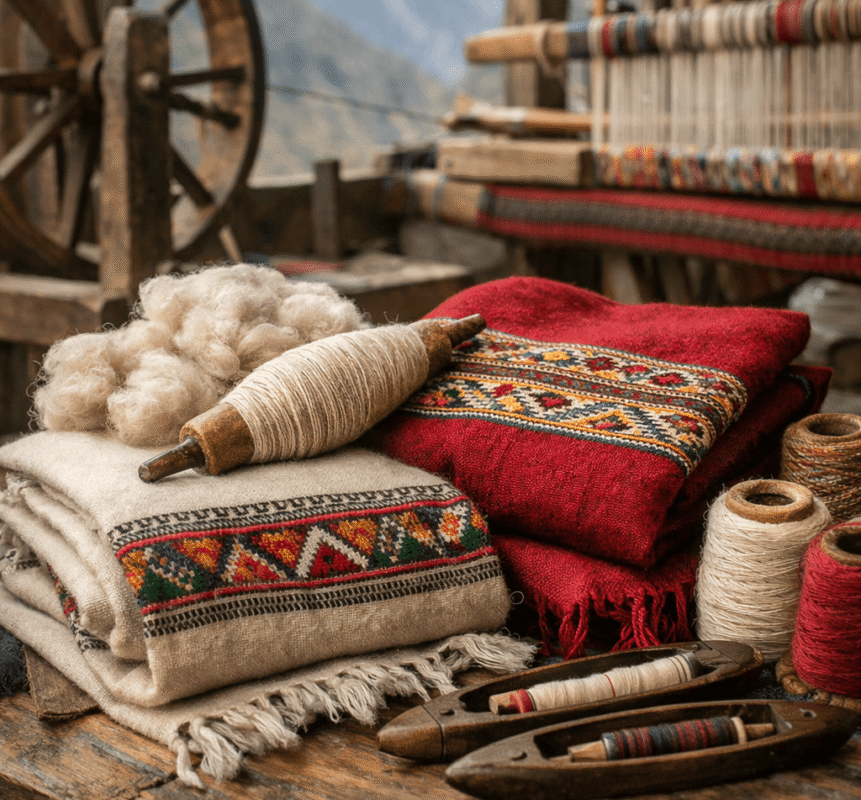The journey of a handwoven stole from the loom to becoming a cherished adornment is a symphony of skill, tradition, and artistic expression. In this detailed exploration, we unravel the intricate process involved in crafting handwoven stoles, focusing on the meticulous steps that transform raw materials into wearable works of art.
Selecting Premium Materials
At the heart of handwoven stoles lies the selection of premium materials. Himalayan regions, including Himachal Pradesh, are known for their high-quality wool and pashmina. The article delves into the careful curation of raw materials, emphasizing the importance of selecting fibers that not only provide warmth but also lend a luxurious feel to the finished stole.
Preparation of Yarn
The preparation of yarn is a crucial step in the handloom process. The article intricately details how raw wool is cleaned, carded, and spun into yarn. The quality of the yarn influences the texture and durability of the final product. Skilled artisans employ traditional spinning techniques, ensuring that each thread is carefully crafted before it finds its place on the loom.
Setting Up the Loom
The loom is the artisan's canvas, and setting it up requires precision and expertise. The article provides a step-by-step guide to the intricate process of preparing the loom, threading it with the carefully spun yarn, and creating the foundation for the handwoven stole. This phase requires not only technical proficiency but also an artistic vision to bring the chosen design to life.
Weaving Techniques
Handwoven stoles boast a rich variety of weaving techniques that contribute to their visual appeal and texture. The article explores techniques such as plain weave, twill weave, and intricate patterns achieved through the interplay of warp and weft. It delves into the artistry involved in creating diverse textures, ensuring that each stole is a unique masterpiece.
Artistic Embellishments
Beyond the basic weaving process, artisans often incorporate artistic embellishments into handwoven stoles. This may include hand-embroidery, beadwork, or the addition of decorative elements that enhance the aesthetic value of the stole. The article examines the creative choices made by artisans, showcasing how these embellishments contribute to the individuality of each piece.
Quality Assurance and Finishing Touches
Ensuring the quality of the handwoven stole is a meticulous process that involves thorough checks at various stages. The article discusses the importance of quality assurance, from checking the tension on the loom to inspecting the finished fabric for consistency and durability. It also explores the finishing touches applied to the stole, such as washing, blocking, and ironing, to prepare it for its journey from the loom to the wearer.
Preservation of Tradition and Future Prospects
The article concludes by highlighting the significance of preserving traditional handloom techniques. It explores the challenges faced by artisans in the face of modernization and globalization and discusses the initiatives undertaken to pass on these time-honored skills to the next generation. The future prospects of handwoven stoles are examined, emphasizing the importance of sustainable practices and the continued appreciation of craftsmanship in a changing world.
In unraveling the detailed process of crafting handwoven stoles, this article invites readers to appreciate the artistry, dedication, and cultural significance woven into each thread.














 Handwoven Shawls
Handwoven Shawls Women Shawls
Women Shawls Handwoven Wool Stoles
Handwoven Wool Stoles Himachali Muffler
Himachali Muffler Himachali Topi
Himachali Topi